25+ Sea Monster Movies: Mutant Creatures From The Deep

Since the horror genre depends in large part upon the unknown, and since nearly three-quarters of the Earth’s surface is covered in water, the ocean is a natural setting for horror movies.Sometimes, the horror is derived from the vast, unknowable, alien darkness of the ocean itself. In films such as The Deep and The Abyss, the ocean itself is the “monster.”
In other cases, the horror comes from evoking a very primal, very natural fear of shark attacks as epitomized in films such as Jaws and 47 Meters Down.
Sea monster movies differ from shark movies in that they are based on real-life creatures such as crabs, frogs, or octopi, but usually in an exaggerated and thus unreal form. Giant sea creatures of legend such as Leviathan and the Kraken differ from great white sharks in that they are at least understood to be the stuff of nightmares rather than reality. (On this list, Sharktopus gets a pass for being half-shark not only because his half-octopus side redeems him, but because no one in their right mind believes that a “Sharktopus” actually exists.) With the context of these movies, sea monsters also differ from sharks in the sense that many of them emerge from the sea to launch their attacks on land.
In many cases, the murderous aquatic beasts in these sea monster movies are the mutant results of either atomic radiation or industrial waste, so there is at least a pro-environmentalist message lurking beneath all the screaming and carnage.
What follows is a list of sea monster movies from the mid-1950s to the present.
Old Sea Monster Movies
The Phantom From 10,000 Leagues (1955)

A radioactive boulder on the ocean floor mutates a commonplace sea creature into a horrific monster. According to 1000 Misspent Hours, “It’s one hell of a monster, too. Though it is portrayed by the standard man in a suit, it really can’t be characterized as a gill-man— ‘vaguely humanoid sea serpent’ might be the best description. It’s a lumpy thing, with a barrel-chested body, short, squat, flipper-like limbs, and a somehow bovine head adorned with a row of backward-curving horns running down the midline from snout to cranium.” As radiation-burned fisherman corpses begin washing ashore, government agents visit a small seaside town and discover that a local oceanographer’s experiments may be at the root of both the radioactivity and the monster. And because this movie is set in the 1950s, of course the Kremlin is funding the oceanographer.
The Monster That Challenged the World (1957)
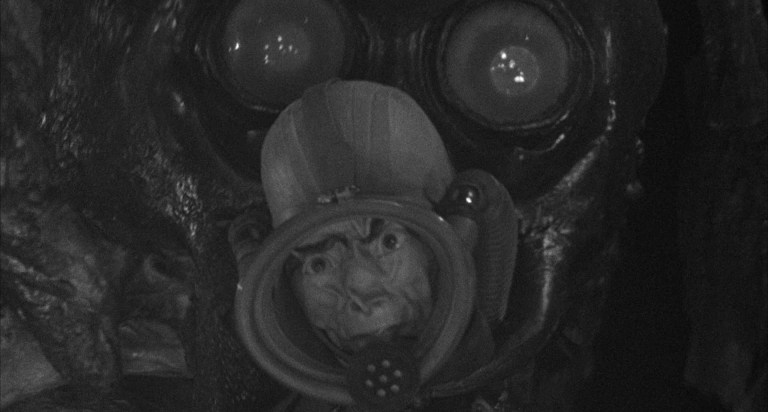
A giant earthquake beneath the Salton Sea, a manmade body of water deep in the California desert, unleashes a formerly dormant squad of giant prehistoric mollusks into the canal system of the Imperial Valley, whereupon they escape into nearby communities and terrorize the locals. A naval commander and a group of scientists set about to quash the mollusk invasion, but are they too late? Speculating that The Monster That Challenged the World might be “the world’s only atomic snail flick,” 1000 Misspent Hours writes that the monster “looks something like a cross between a snail and a centipede, and though it’s a bit hard to get a fix on its size, I’d say it’s got to be at least 18 feet long and weigh most of a ton.”
Attack of the Crab Monsters (1957)
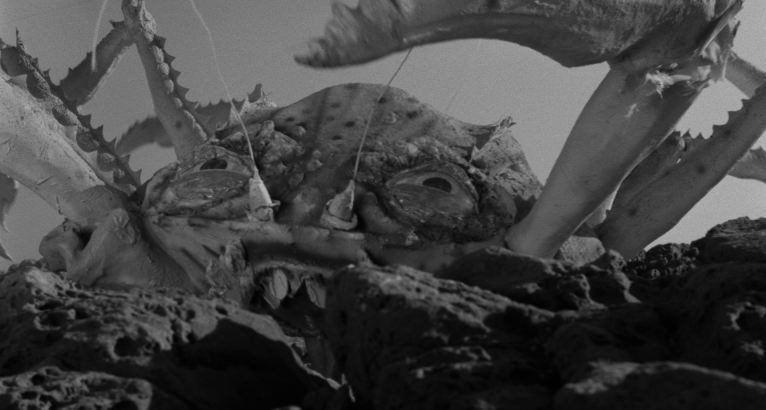
B-movie king Roger Corman produced this movie, which was one of nine movies the tireless schlockmeister churned out in 1957. Studying the effects of nuclear-weapons tests, a group of scientists travel to a remote island, where they wind up stranded after their airplane explodes. They are immediately set upon by giant crablike creatures who are not only intelligent, they are empathic and can speak a pretentiously affected form of modern English: “So you have wounded me! I must grow a new claw, well and good, for I can do it in a day — but will you grow new lives when I have taken yours from you?” To add even more urgency, the entire island is sinking into the sea. Russell Wilson, who would gain fame in the 1960s as “The Professor” on TV sitcom Gilligan’s Island, portrays the lead crab-fighting scientist.
The Horror of Party Beach (1964)

While a rock band plays on the beach and greasers engage in knife fights over chicks, a careless sea trawler dumps barrels of radioactive waste into the ocean, causing a mutant breed of frog-like gilled creatures who appear to have hot dogs stuffed into their mouths to rise from the water and prey upon mostly nubile young women. By accident—almost the same way the Charles Goodyear discovered vulcanized rubber—a hapless scientist’s black maid Eulabell discovers that the monsters, who are mostly made of water, can be destroyed if exposed to sodium. But will they find enough sodium in time to squash the monster invasion? All Movie writes, “Stuffed with nearly all the essential ingredients for a ’50s drive-in classic — including rubber monsters, clean-cut biker gangs, countless inane rock & roll numbers, and twistin’ teeny-boppers who appear to be about 35 — this uproariously awful monster flick has secured a fond place in the hearts of bad-movie buffs.”
Godzilla vs. the Sea Monster (1968)
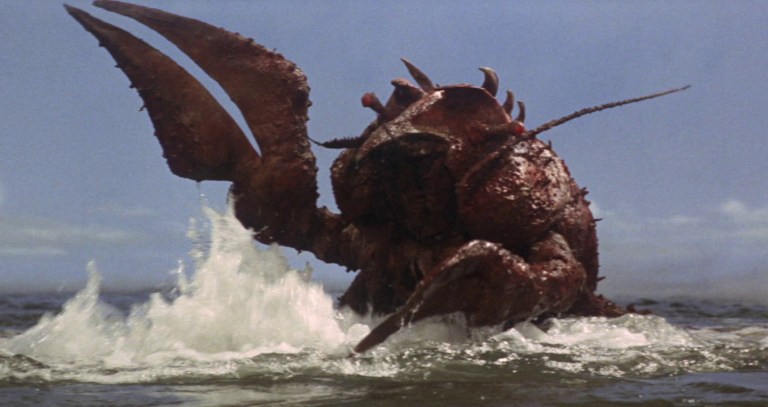
Originally released in Japan two years earlier as Ebirah, Horror of the Deep, this lightly regarded installment in the kaiju canon finds Godzilla going up against a giant crustacean—literally translated, “Ebirah” means “Shrimpzilla.” The action starts when a group of teens get shipwrecked on Letchi Island after being attacked at sea by Ebirah. The monster prawn is being used to protect the island by some sort of shady international terrorist organization called the Red Bamboo. As their tremendous luck would have it, the group finds Godzilla hibernating on the island. They direct the lightning that often strikes the island’s mountains toward Godzilla, who is so angry at being abruptly awakened that he fights Ebirah. Critics have noted that the battle scenes don’t seem as spectacular as in other Godzilla movies because the film is set on a rural island and there are no giant buildings to smash or electrical cables to destroy.
Tentacles (1977)

After a string of mysterious disappearances along the Southern California coast involving bodies that eventually wash up picked clean to the bone, investigators begin to wonder if it’s at all related to the construction of an underwater tunnel. When divers attempt to investigate further, they are killed by a giant octopus. It appears as if illegal radio frequencies are triggering the octopus into bouts of feel rage. There are shades of Jaws in the plot, as oceanographers and lawmen clash on how best to slay the creature without garnering undue negative publicity that’s sure to harm the local tourism industry. As cheap as it sounds, Tentacles stars Hollywood stalwarts such as Henry Fonda, Shelley Winters, and John Huston. Released in Italy as Tentacoli.
New Sea Monster Movies
Leviathan (1989)

Peter Weller of Robocop fame stars as Steven Beck, an oceanographer leading a group of deep-sea miners in the excavation project of a wrecked Soviet freight ship named Leviathan. But they find more than sunken gold—they find a massive sea creature that’s the result of a failed genetic experiment. And then, to their horror, the crew starts to realize that their own genes have been altered, too. The Washington Post writes, “The underwater scenes are hypnotic in a way that outer-space scenes seldom are anymore….Mike Valentine’s underwater photography and Ron Cobb’s production design for this corporate Sea World are quite good, and those who’ve always wondered how Amanda Pays would fare in a wet-T-shirt contest may want to catch this film.”
The Host (2006)
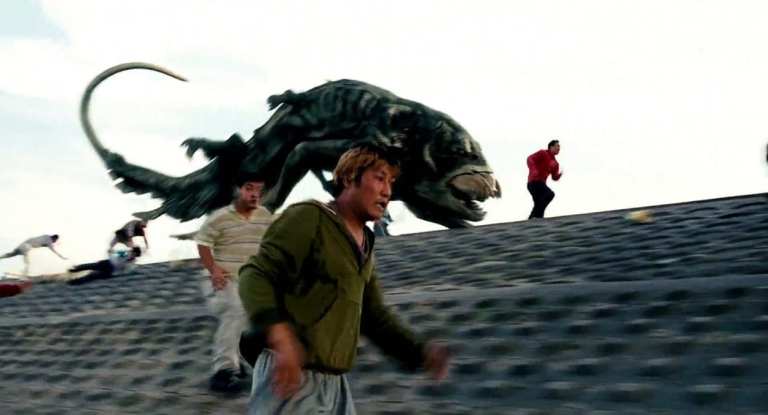
As is the case with so many sea-monster movies, hazardous chemicals dumped into a body of water give rise to a mutant sea creature that rises from the depths and attacks people. This time around, the chemicals are dumped from an American military base into Seoul, Korea’s Han River. At a pivotal point in the film, the giant malevolent squid-like monster kidnaps a pre-teen girl named Hyun-seo and confines her to his underwater domain. But much of the government’s energies is distracted away from the giant pedophilic sea creature and toward fighting a land-based flu-like pandemic. Reel Views writes, “The Host is a strange little movie: part creature feature, part social commentary, and part slapstick comedy….The film’s best scenes are those involving Hyun-seo trapped in the creature’s lair. Her cat-and-mouse game with it generates a good deal of tension; it’s annoying when the movie cuts from her scenes to those involving pointless secondary characters involved in the political/virus subplot.” The film set box-office records in South Korea.
Beyond Loch Ness (2008)
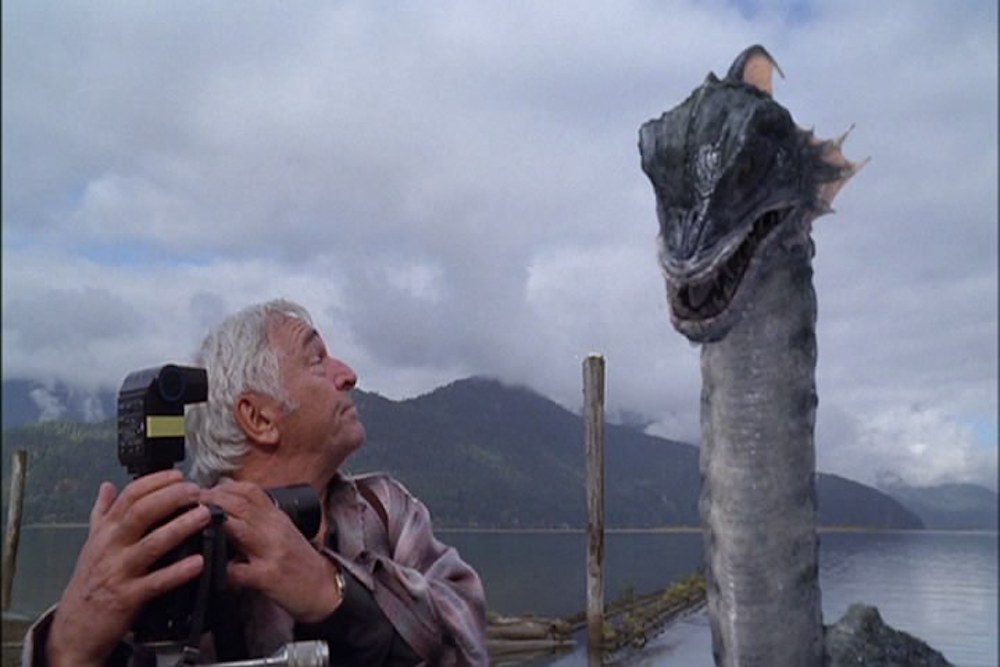
The Loch Ness Monster, AKA “Nessie,” is up there with Leviathan and the Kraken as one of the most legendary aquatic monsters of all time, with the main difference being that many people insist that Nessie is real rather than a pure creature of myth. James Murphy (Brian Krause) is an aging and cynical cryptozoologist who thirty years prior witnessed his own father being killed by Nessie in Scotland. Fast-forward to the present, and there are a rash of brutal murders in a small village on the banks of Lake Superior. It appears as if the plesiosaurs have spread from Scotland to the United States—and not only that, they’re breeding with each other and killing human beings. Film Critics United writes, “The key to any decent monster movie is the monster and Nessie over here was a decent one. She wasn’t animated too badly, integrated well into the surroundings, and seemed only to exist to eat Canadians.”
Sharktopus Versus Pteracuda (2014)
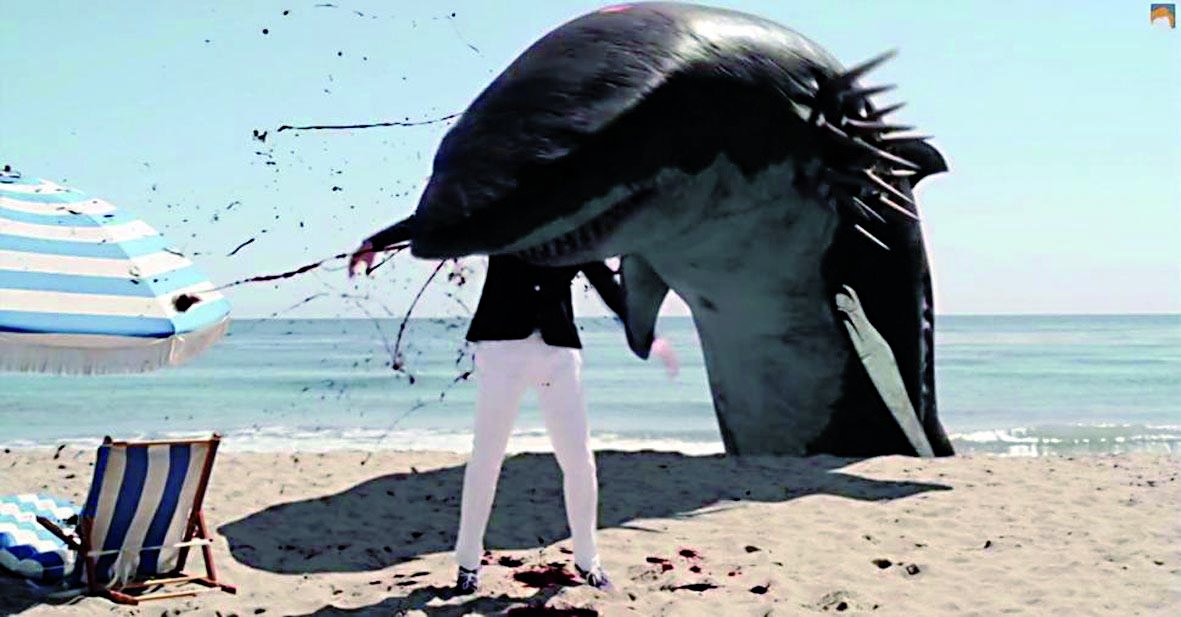
Yet another installment in the SyFy’s so-bad-it’s-good series of poorly animated mutant creatures, this sequel to 2010’s Sharktopus pits a giant shark/octopus hybrid against a giant pterodactyl/barracuda hybrid, both of which are rendered extra-dangerous by the fact that they are able to fly and swim. Set in the Dominican Republic, this film finds the malevolent Dr. Rico Symes (Keith Carradine) planting a chip in the brain of the Sharktopus, hoping it will be able to find and kill the Pterocuda, his last rogue genetic creation. The film brought producer Roger Corman out of retirement merely to direct a scene in which Conan O’Brien, appearing as an obnoxious preppie yachtsman, gets his head bitten off by a giant flying reptile.
Bermuda Tentacles (2014)
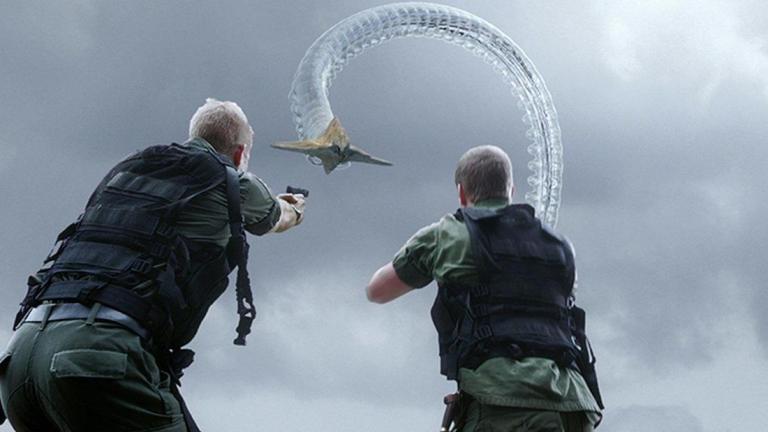
The Bermuda Triangle in the Caribbean Ocean is infamous for the number of unexplained disappearances and tragedies involving both ocean vessels and aircraft that dare to traverse its boundaries. In this film by director Nick Lyon, a bolt of lightning destroys one of Air Force One’s engines as it’s flying over the Bermuda Triangle, causing it to crash into the ocean. The President of the United States escapes into the water inside a small, self-contained pod. As a Special Forces team attempts to locate the president before he runs out of oxygen, massive sets of tentacles rise up from the ocean floor, seeking to kill everything in their path. Based on the size of its tentacles alone, the monster may be able to destroy the USA’s entire Eastern Seaboard. Will they be able to it in time? And in the grand scheme of things, is saving the East Coast more important than saving the president?
Sweetheart (2019)

While on an ocean excursion with her boyfriend Lucas and a few others, Jenn (Kiersey Clemons), washes ashore after an ocean storm to find herself entirely alone on a remote island. One night as a plane passes overhead, Jenn lights a signal flare, hoping to attract the plane’s attention. This she fails to do, but the light of the flare illuminates a massive horrific creature standing above the sea a few hundred yards from shore. While swimming one day, Jenn also spots a giant black hole in the ocean floor—presumably the sea creature’s lair. At night she must deal with the terror of knowing that this is when the creature emerges from the sea to hunt for prey amidst the island’s jungle. When her boyfriend Lucas and their friend Mia arrive a week later on a raft, Jenn tries to warn them about the monster, but they don’t believe her.
Luca (2021)

An animated collaboration between Disney and Pixar, Luca is set on the Italian Riviera during summertime. It tells the story of two young boys, Luca and Alberto, who decide to spend the summer in the quaint little fishing village of Portorosso. Although they are embraced by the locals and spend their days eating gelato and breezing through the hills on scooters, they are sworn to keep one thing secret—they are actually sea monsters who are merely curious about how the “other half” lives on dry land. ABC Entertainment writes, “The real magic of Luca is its visuals….The distinctions separating a Pixar creation from a Disney animated feature seem to be blurring in cases like this, but [director and animator Enrico] Casarosa has a winning knack for folding the wonder of fairy tales into the joys of old-fashioned storytelling.”
More Sea Monster Movies
- Creature from the Haunted Sea (1961) master of B-movies Roger Corman presents this horror comedy about a criminal who kills people, dumps their bodies into the sea, and blames it on a sea monster—but he doesn’t realize that there’s actually a sea monster in the ocean.
- Gorgo (1961) Imagine Godzilla emerging from the deep to attack London instead of Tokyo, and you have Gorgo.
- Slithis (1978) another nuclear leak creates another hideous gilled sea monster, but this time it attacks hippies and bums around Venice, CA.
- Bog (1979) While dynamite-fishing in the Louisiana bayou, fishermen unwittingly unleash a prehistoric swamp creature with a thirst for the blood of human females.
- The Island of the Fishmen (1979) released in Italy as L’isola degli uomini pesce, this exploitation thriller features a mutant breed of gilled sea creatures who terrorize a remote atoll.
- Clash of the Titans (1981) Greek mythological hero Perseus (Harry Hamlin) must battle the fearsome sea creature the Kraken to save Princess Andromeda (Claire Bloom).
- Bloodtide (1982) James Earl Jones stars as an adventurer in the Greek Islands who accidentally unleashes a prehistoric sea creature who has a fondness for sacrificing virgins.
- The Sea Serpent (1985) a giant radioactive fanged sea snake preys upon the frightened residents of a Spanish seaside village. Released in Spain as Serpiente de mar.
- They Bite (1996) is, according to director Bill Piper, a horror comedy about “fish monsters and tits.” Lecherous sea monsters emerge from the deep to seek out human female mating partners.
- Kraa! The Sea Monster (1998) a “sea creature” is sent from outer space to dominate the Earth, but he accidentally lands in New Jersey instead of Italy.
- Deep Rising (1998) flesh-eating sea monsters emerge to devour the passengers on a luxury cruise liner in the South China Sea.
- Creature from the Hillbilly Lagoon (2005) a giant frog-like creature plumbs the deaths of the titular lagoon. Tagline: “It turns rednecks into deadnecks.”
